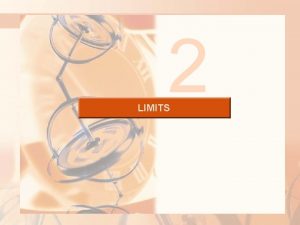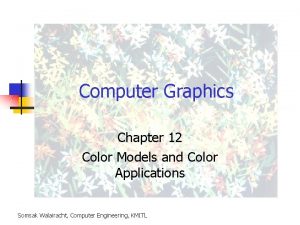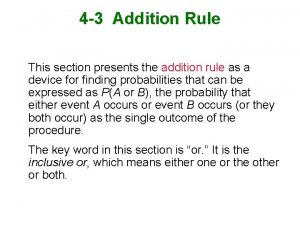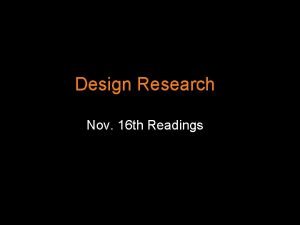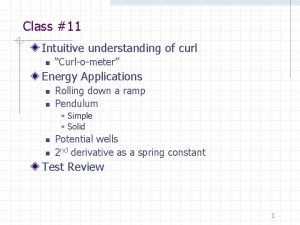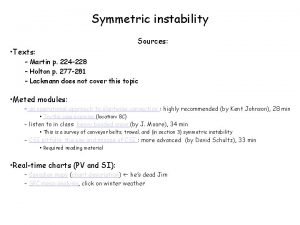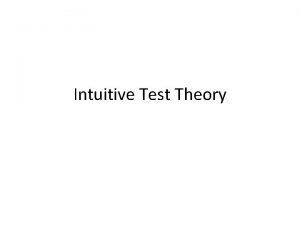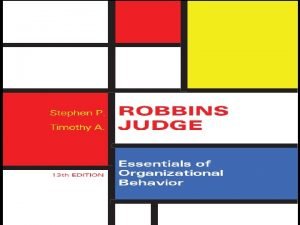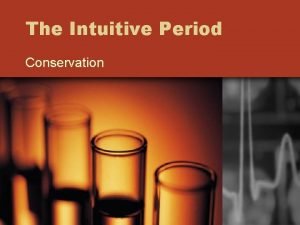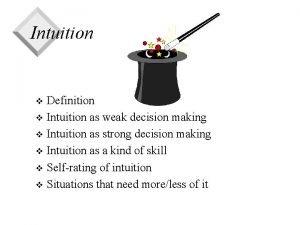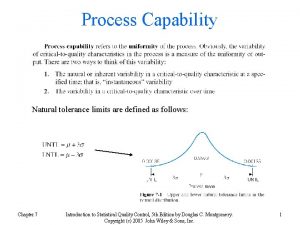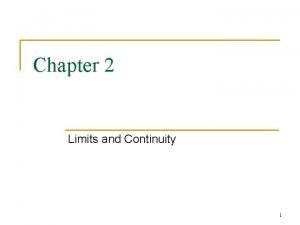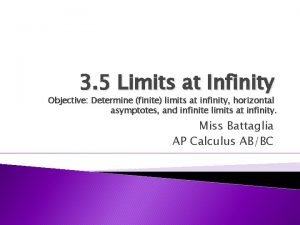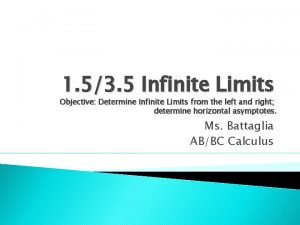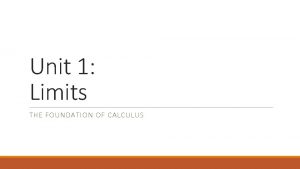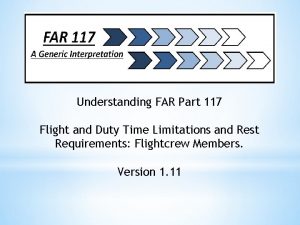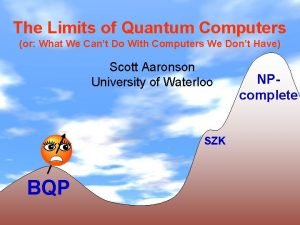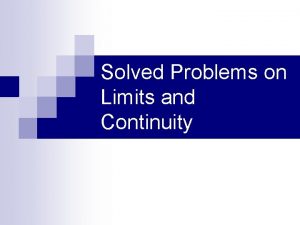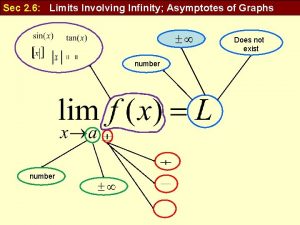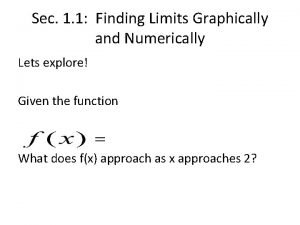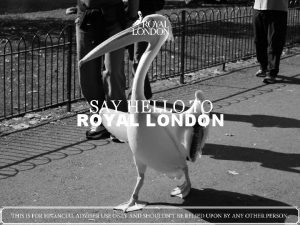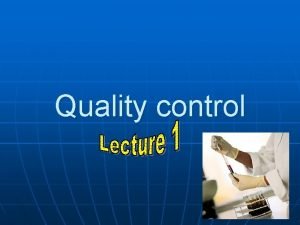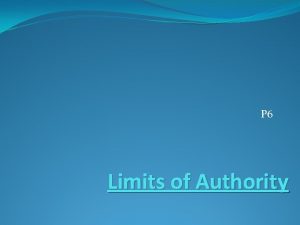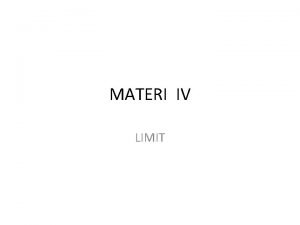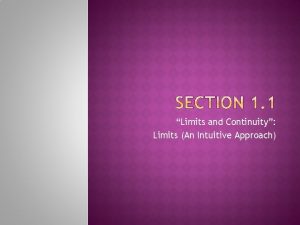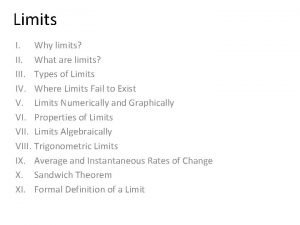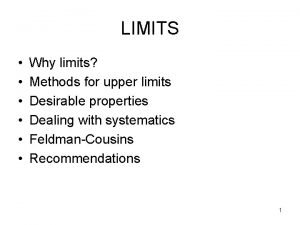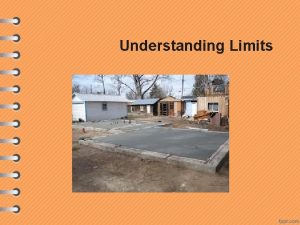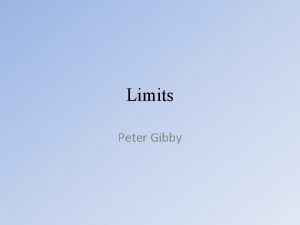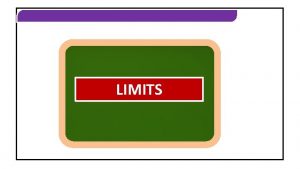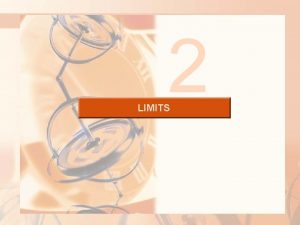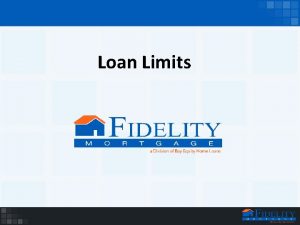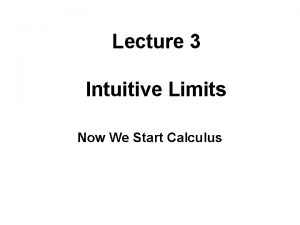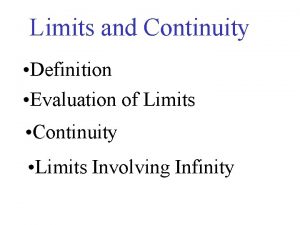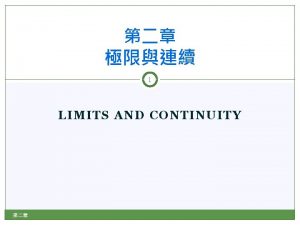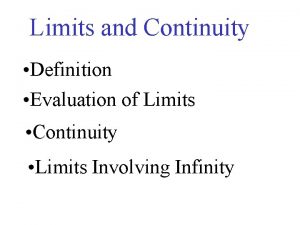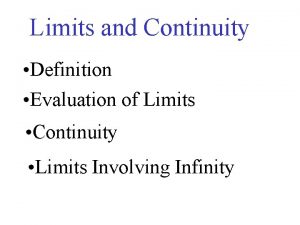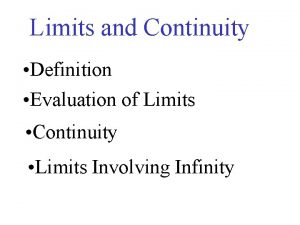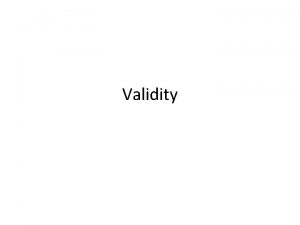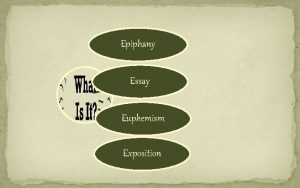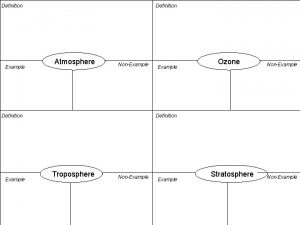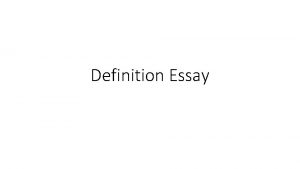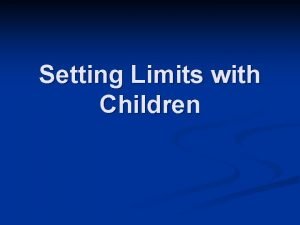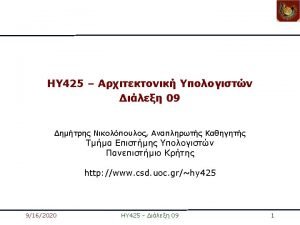2 LIMITS LIMITS The intuitive definition of a











































































- Slides: 75

2 LIMITS

LIMITS The intuitive definition of a limit given in Section 2. 2 is inadequate for some purposes. § This is because such phrases as ‘x is close to 2’ and ‘f(x) gets closer and closer to L’ are vague. § In order to be able to prove conclusively that we must make the definition of a limit precise.

LIMITS 2. 4 The Precise Definition of a Limit In this section, we will: Define a limit precisely.

PRECISE DEFINITION OF LIMIT To motivate the precise definition of a limit, consider the function § Intuitively, it is clear that when x is close to 3 but , then f(x) is close to 5—and so .

PRECISE DEFINITION OF LIMIT To obtain more detailed information about how f(x) varies when x is close to 3, we ask the following question. § How close to 3 does x have to be so that f(x) differs from 5 by less than 0. l?

PRECISE DEFINITION OF LIMIT The distance from x to 3 is |x - 3| and the distance from f(x) to 5 is |f(x) - 5|. So, our problem is to find a number such that

PRECISE DEFINITION OF LIMIT If , then. So, an equivalent formulation of our problem is to find a number such that

PRECISE DEFINITION OF LIMIT Notice that, if then , That is, § Thus, an answer to the problem is given by § That is, if x is within a distance of 0. 05 from 3, then f(x) will be within a distance of 0. 1 from 5. .

PRECISE DEFINITION OF LIMIT If we change the number 0. 1 in our problem to the smaller number 0. 01, then, by using the same method, we find that f(x) will differ from 5 by less than 0. 01—provided that x differs from 3 by less than (0. 01)/2 = 0. 005

PRECISE DEFINITION OF LIMIT Similarly, § The numbers 0. 1, 0. 01, and 0. 001 that we have considered are ‘error tolerances’ that we might allow.

PRECISE DEFINITION OF LIMIT For 5 to be the precise limit of f(x) as x approaches 3, we must not only be able to bring the difference between f(x) and 5 below each of these three numbers, we must be able to bring it below any positive number. § By the same reasoning, we can.

PRECISE DEFINITION OF LIMIT Definition 1 If we write for an arbitrary positive number, then we find as before that: § This is a precise way of saying that f(x) is close to 5 when x is close to 3. § This is because (1) states that we can make the values of f(x) within an arbitrary distance from 5 by taking the values of x within a distance from 3 (but ).

PRECISE DEFINITION OF LIMIT Note that Definition 1 can be rewritten as follows. This is illustrated in the figure.

PRECISE DEFINITION OF LIMIT By taking the values of x ( ) to lie in the interval , we can make the values of f(x) lie in the interval.

PRECISE DEFINITION OF LIMIT Using (1) as a model, we give a precise definition of a limit.

PRECISE DEFINITION OF LIMIT Definition 2 Let f be a function defined on some open interval that contains the number a, except possibly at a itself. Then, we say that the limit of f(x) as x approaches a is L, and we write if, for every number , there is a number such that

PRECISE DEFINITION OF LIMIT Since |x - a| is the distance from x to a and |f(x) - L| is the distance from f(x) to L, and since can be arbitrarily small, the definition can be expressed in words as follows. § means that the distance between f(x) and L can be made arbitrarily small by taking the distance from x to a sufficiently small (but not 0). § Alternatively, means that the values of f(x) can be made as close as we please to L by taking x close enough to a (but not equal to a).

PRECISE DEFINITION OF LIMIT We can also reformulate Definition 2 in terms of intervals by observing that the inequality is equivalent to , which in turn can be written as.

PRECISE DEFINITION OF LIMIT Also, is true if and only if , that is, . Similarly, the inequality is equivalent to the pair of inequalities.

PRECISE DEFINITION OF LIMIT Therefore, in terms of intervals, Definition 2 can be stated as follows. means that, for every (no matter how small is), we can find such that, if x lies in the open interval and , then f(x) lies in the open interval.

PRECISE DEFINITION OF LIMIT We interpret this statement geometrically by representing a function by an arrow diagram as in the figure, where f maps a subset of onto another subset of.

PRECISE DEFINITION OF LIMIT The definition of limit states that, if any small interval is given around L, then we can find an interval around a such that f maps all the points in (except possibly a) into the interval.

PRECISE DEFINITION OF LIMIT Another geometric interpretation of limits can be given in terms of the graph of a function.

PRECISE DEFINITION OF LIMIT If is given, then we draw the horizontal lines and the graph of f.

PRECISE DEFINITION OF LIMIT If , then we can find a number such that, if we restrict x to lie in the interval and take , then the curve y = f(x) lies between the lines and.

PRECISE DEFINITION OF LIMIT You can see that, if such a has been found, then any smaller will also work.

PRECISE DEFINITION OF LIMIT It is important to realize that the process illustrated in the figures must work for every positive number , no matter how small it is chosen.

PRECISE DEFINITION OF LIMIT The third figure shows that, if a smaller is chosen, then a smaller may be required.

PRECISE DEFINITION OF LIMIT Example 1 Use a graph to find a number such that § In other words, find a number that corresponds to in the definition of a limit for the function with a = 1 and L = 2.

PRECISE DEFINITION OF LIMIT Example 1 A graph of f is shown. We are interested in the region near the point (1, 2).

PRECISE DEFINITION OF LIMIT Example 1 Notice that we can rewrite the inequality as § So, we need to determine the values of x for which the curve lies between the horizontal lines y = 1. 8 and y = 2. 2.

PRECISE DEFINITION OF LIMIT Example 1 § Therefore, we graph the curves y = 1. 8, and y = 2. 2 near the point (1, 2). § Then, we use the cursor to estimate that the x-coordinate of the point of intersection of the line y = 2. 2 and the curve is about 0. 911 ,

PRECISE DEFINITION OF LIMIT Example 1 § Similarly, intersects the line y = 1. 8 when § So, rounding to be safe, we can say that

PRECISE DEFINITION OF LIMIT Example 1 This interval (0. 92, 1. 12) is not symmetric about x = 1. § The distance from x = 1 to the left endpoint is 1 - 0. 92 = 0. 08 and the distance to the right endpoint is 0. 12

PRECISE DEFINITION OF LIMIT Example 1 We can choose to be the smaller of these numbers—that is, § Then, we can rewrite our inequalities in terms of distances:

PRECISE DEFINITION OF LIMIT Example 1 This just says that, by keeping x within 0. 08 of 1, we are able to keep f(x) within 0. 2 of 2. § Though we chose any smaller, positive value of would also have worked. ,

PRECISE DEFINITION OF LIMIT The graphical procedure in the example gives an illustration of the definition for However, it does not prove that the limit is equal to 2. § A proof has to provide a for every.

PRECISE DEFINITION OF LIMIT In proving limit statements, it may be helpful to think of the definition of limit as a challenge. § First, it challenges you with a number. § Then, you must be able to produce a suitable. § You have to be able to do this for every , not just a particular.

PRECISE DEFINITION OF LIMIT Imagine a contest between two people, A and B. Imagine yourself to be B. § A stipulates that the fixed number L should be approximated by the values of f(x) to within a degree of accuracy (say 0. 01). § Then, B responds by finding a number such that, if , then.

PRECISE DEFINITION OF LIMIT § Then, A may become more exacting and challenge B with a smaller value of (say, 0. 0001). § Again, B has to respond by finding a corresponding. § Usually, the smaller the value of , the smaller the corresponding value of must be. § If B always wins, no matter how small A makes , then.

PRECISE DEFINITION OF LIMIT Prove that: Example 2

STEP 1: GUESSING THE VALUE Example 2 The first step is the preliminary analysis—guessing a value for. § Let be a given positive number. § We want to find a number such that § However,

STEP 1: GUESSING THE VALUE Example 2 § Therefore, we want § That is, § This suggests that we should choose .

STEP 2: PROOF Example 2 The second step is the proof— showing that this works. § Given § If , choose , then . § Thus, § Therefore, by the definition of a limit,

PRECISE DEFINITION OF LIMIT Example 2 The example is illustrated by the figure.

PRECISE DEFINITION OF LIMIT Note that, in the solution of the example, there were two stages—guessing and proving. § We made a preliminary analysis that enabled us to guess a value for. § In the second stage, though, we had to go back and prove in a careful, logical fashion that we had made a correct guess.

PRECISE DEFINITION OF LIMIT This procedure is typical of much of mathematics. § Sometimes, it is necessary to first make an intelligent guess about the answer to a problem and then prove that the guess is correct.

PRECISE DEFINITION OF LIMIT The intuitive definitions of one-sided limits given in Section 2. 2 can be precisely reformulated as follows.

PRECISE DEFINITION OF LIMIT Definition 3 Left-hand limit is defined as follows. if, for every number , there is a number such that § Notice that Definition 3 is the same as Definition 2 except that x is restricted to lie in the left half of the interval.

PRECISE DEFINITION OF LIMIT Definition 4 Right-hand limit is defined as follows. if, for every number , there is a number such that § In Definition 4, x is restricted to lie in the right half of the interval.

PRECISE DEFINITION OF LIMIT Use Definition 4 to prove that: Example 3

STEP 1: GUESSING THE VALUE Example 3 Let be a given positive number. § Here, a = 0 and L = 0, so we want to find a number such that. § That is, . § Squaring both sides of the inequality , we get. § This suggests that we should choose.

STEP 2: PROOF Given § If § So, Example 3 , let , then . . . § According to Definition 4, this shows that

PRECISE DEFINITION OF LIMIT Prove that: Example 4

STEP 1: GUESSING THE VALUE Example 4 Let be given. § We have to find a number such that § To connect we write § Then, we want with

STEP 1: GUESSING THE VALUE Example 4 Notice that, if we can find a positive constant C such that , then and we can make. by taking

STEP 1: GUESSING THE VALUE Example 4 We can find such a number C if we restrict x to lie in some interval centered at 3. § In fact, since we are interested only in values of x that are close to 3, it is reasonable to assume that x is within a distance 1 from 3, that is, . § Then, , so. § Thus, we have , and so C = 7 is a suitable choice for the constant.

STEP 1: GUESSING THE VALUE Example 4 However, now, there are two restrictions on , namely and § To make sure that both inequalities are satisfied, we take to be the smaller of the two numbers 1 and. § The notation for this is.

STEP 2: PROOF Given Example 4 , let . § If , then (as in part l). § We also have § This shows that , so .

PRECISE DEFINITION OF LIMIT As the example shows, it is not always easy to prove that limit statements are true using the definition. § In fact, if we had been given a more complicated function such as , a proof would require a great deal of ingenuity.

PRECISE DEFINITION OF LIMIT Fortunately, this is unnecessary. § This is because the Limit Laws stated in Section 2. 3 can be proved using Definition 2. § Then, the limits of complicated functions can be found rigorously from the Limit Laws—without resorting to the definition directly.

PRECISE DEFINITION OF LIMIT For instance, we prove the Sum Law. § If and both exist, then

PROOF OF THE SUM LAW Let be given. § We must find such that

PROOF OF THE SUM LAW Definition 5 Using the Triangle Inequality we can write:

PROOF OF THE SUM LAW We make less than by making each of the terms and less than. § Since and such that § Similarly, since such that , there exists a number

PROOF OF THE SUM LAW Let . § Notice that § So, and § Therefore, by Definition 5,

PROOF OF THE SUM LAW To summarize, Thus, by the definition of a limit,

INFINITE LIMITS Infinite limits can also be defined in a precise way. § The following is a precise version of Definition 4 in Section 2. 2.

INFINITE LIMITS Definition 6 Let f be a function defined on some open interval that contains the number a, except possibly at a itself. Then, means that, for every positive number M, there is a positive number such that

INFINITE LIMITS The definition states that the values of f(x) can be made arbitrarily large (larger than any given number M) by taking x close enough to a (within a distance , where depends on M, but with ).

INFINITE LIMITS A geometric illustration is shown in the figure. § Given any horizontal line y = M, we can find a number such that, if we restrict x to lie in the interval but , then the curve y = f(x) lies above the line y = M. § You can see that, if a larger M is chosen, then a smaller may be required.

INFINITE LIMITS Example 5 Use Definition 6 to prove that § Let M be a given positive number. § We want to find a number such that § However, § So, if we choose then. § This shows that and as , .

INFINITE LIMITS Similarly, the following is a precise version of Definition 5 in Section 2. 2.

INFINITE LIMITS Definition 7 Let f be a function defined on some open interval that contains the number a, except possibly at a itself. Then, means that, for every negative number N, there is a positive number such that

INFINITE LIMITS This is illustrated by the figure.
 Intuitive notion of limits
Intuitive notion of limits Intuitive intelligence
Intuitive intelligence Lim as x approaches infinity
Lim as x approaches infinity Shape 65
Shape 65 Cmy and hsv color model
Cmy and hsv color model Formal addition rule
Formal addition rule Intuitive projective faith
Intuitive projective faith Analytical intuitive functional and personal
Analytical intuitive functional and personal Intuitive design fallout 4
Intuitive design fallout 4 Intuitive curl care
Intuitive curl care Intuitive
Intuitive Intuitive test
Intuitive test Intuitive decision making
Intuitive decision making Intuitive period
Intuitive period Intuitive thinking example
Intuitive thinking example 2. 'foresight is deeply rooted within intuitive mind.'
2. 'foresight is deeply rooted within intuitive mind.' Intuitive perspective
Intuitive perspective Hình ảnh bộ gõ cơ thể búng tay
Hình ảnh bộ gõ cơ thể búng tay Slidetodoc
Slidetodoc Bổ thể
Bổ thể Tỉ lệ cơ thể trẻ em
Tỉ lệ cơ thể trẻ em Voi kéo gỗ như thế nào
Voi kéo gỗ như thế nào Tư thế worm breton là gì
Tư thế worm breton là gì Hát lên người ơi
Hát lên người ơi Môn thể thao bắt đầu bằng từ đua
Môn thể thao bắt đầu bằng từ đua Thế nào là hệ số cao nhất
Thế nào là hệ số cao nhất Các châu lục và đại dương trên thế giới
Các châu lục và đại dương trên thế giới Công của trọng lực
Công của trọng lực Trời xanh đây là của chúng ta thể thơ
Trời xanh đây là của chúng ta thể thơ Mật thư anh em như thể tay chân
Mật thư anh em như thể tay chân 101012 bằng
101012 bằng Phản ứng thế ankan
Phản ứng thế ankan Các châu lục và đại dương trên thế giới
Các châu lục và đại dương trên thế giới Thơ thất ngôn tứ tuyệt đường luật
Thơ thất ngôn tứ tuyệt đường luật Quá trình desamine hóa có thể tạo ra
Quá trình desamine hóa có thể tạo ra Một số thể thơ truyền thống
Một số thể thơ truyền thống Cái miệng nó xinh thế chỉ nói điều hay thôi
Cái miệng nó xinh thế chỉ nói điều hay thôi Vẽ hình chiếu vuông góc của vật thể sau
Vẽ hình chiếu vuông góc của vật thể sau Nguyên nhân của sự mỏi cơ sinh 8
Nguyên nhân của sự mỏi cơ sinh 8 đặc điểm cơ thể của người tối cổ
đặc điểm cơ thể của người tối cổ Giọng cùng tên là
Giọng cùng tên là Vẽ hình chiếu đứng bằng cạnh của vật thể
Vẽ hình chiếu đứng bằng cạnh của vật thể Phối cảnh
Phối cảnh Thẻ vin
Thẻ vin đại từ thay thế
đại từ thay thế điện thế nghỉ
điện thế nghỉ Tư thế ngồi viết
Tư thế ngồi viết Diễn thế sinh thái là
Diễn thế sinh thái là Dot
Dot Thế nào là số nguyên tố
Thế nào là số nguyên tố Tư thế ngồi viết
Tư thế ngồi viết Lời thề hippocrates
Lời thề hippocrates Thiếu nhi thế giới liên hoan
Thiếu nhi thế giới liên hoan ưu thế lai là gì
ưu thế lai là gì Sự nuôi và dạy con của hổ
Sự nuôi và dạy con của hổ Sự nuôi và dạy con của hổ
Sự nuôi và dạy con của hổ Hệ hô hấp
Hệ hô hấp Từ ngữ thể hiện lòng nhân hậu
Từ ngữ thể hiện lòng nhân hậu Thế nào là mạng điện lắp đặt kiểu nổi
Thế nào là mạng điện lắp đặt kiểu nổi Natural tolerance limits definition
Natural tolerance limits definition Limits at infinity definition
Limits at infinity definition How to find horizontal asymptotes
How to find horizontal asymptotes Rules for limits to infinity
Rules for limits to infinity Dts 500 gate motor reset
Dts 500 gate motor reset Special trig limits
Special trig limits 117 table b
117 table b The limits of quantum computers
The limits of quantum computers Limits and continuity problems with solutions
Limits and continuity problems with solutions Limits of rational functions
Limits of rational functions Limits of composite functions
Limits of composite functions Royal london medical underwriting limits
Royal london medical underwriting limits How to calculate control limits
How to calculate control limits Disintegration definition
Disintegration definition Pnenumbra
Pnenumbra Examples of limits of authority
Examples of limits of authority Limits of
Limits of
